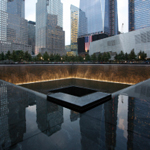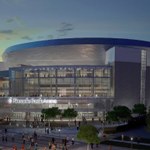As early as the mid-1600s, colonialists began dotting the eastern half of Pennsylvania with small burghs, eventually reaching the location of present-day Allentown, settled in 1751. It wasn’t until the Industrial Revolution in the mid-1800s, though, that the region became an economic destination, and Allentown’s proximity to the Lehigh Canal plugged it into a growing manufacturing network as local iron and railroad companies popped up in the town’s Center City business district—with beer breweries soon to follow.
Center City’s Master Plan
Here’s a breakdown of the plan’s main buildings and the particular amenities each will include.
One City Center• 180,000 square feet, seven floors
• Class A, mixed-use office building
• Brick-and-glass façade
• Fitness center, underground parking
• Direct arena access
• Headquarters of LVHN Sports Medicine
Arena Hotel
• 145,000 square feet, seven floors
• 180 rooms, fully serviced
• Restaurant space and meeting and banquet rooms
• Direct arena access
• Connected to One City Center and parking
Two City Center
• 300,000 square feet, 11 floors
• Class A, mixed-use office building
• Brick-and-limestone façade
• 7,200 square feet of green roof space
• Environmental control systems
• Lutron lighting systems
• Headquarters of National Penn Bancorp
Three City Center
• 203,000 square feet, five floors
• Class-A, mixed-use office building
• Brick-and-limestone façade
• Green roof space
• Three-level, 570-space underground parking garage
• Designed for multiple tenants
However, by the mid-20th century, many of the breweries had closed or consolidated, and the other industries had either faded or gone elsewhere. Center City went the way of many American downtowns, and it wasn’t until developers targeted the area for the construction of a new $272 million arena for the Lehigh Valley Phantoms AHL hockey team—to be completed in 2014—that the city of Allentown and the City Center Investment Corporation (CCIC) saw the opportunity for a grand revitalization.
Allentown today comprises a metropolitan population of a little more than 816,000 people. Center City is still the town’s primary business district, and it is also the most densely populated area, with an estimated 54,000 residents. The 23-story, Art Deco-style PPL Building is the tallest in the district, and the architectural diversity and rich history of other public and private buildings in Center City weave a mixed aesthetic throughout the downtown. Recently, because of the new arena, the city of Allentown was able to designate 128 acres of the surrounding area as the Neighborhood Improvement Zone, a special tax district that aims to attract new developers to the struggling community.
This is when the CCIC, headed by corporation president J. B. Reilly, got involved. “We’ve been a long-time property owner in downtown Allentown,” he says, “so [when] we saw the tax-zone opportunities and pulled together development sites around the arena, we were able to form a very cohesive master plan for the area.”
CCIC launched its master plan to develop in conjunction with the construction of the arena, believing that it will help further reform the environment and economy of downtown Allentown. Included in the master plan is a trio of mixed-use office buildings, one with direct access to the arena and another with 7,200 square feet of green roof space; a 180-room hotel that’s also connected to the arena; and a new parking structure and mixed-use residential development. The idea is to create enough activity around the sports facility to draw patrons back to the downtown district for shopping, eating, and work, and their money will help fuel further development. “What we’re really trying to do is plan and develop this area—to create a vibrant urban environment by bringing all of these different things together at the same time,” Reilly says.
CCIC has been working closely with Hammes Company, the developer of the arena, in order to ensure a developmental and infrastructural coherency for the transformation of downtown Allentown. And largely because of CCIC’s attractive precedent, other developers are now targeting other areas of Center City to carry out further revitalization efforts
“When you look at the map of the area, you see a great arts district, some areas of strong corporate presence, and then this other section where we are working,” Reilly says. “What we are looking forward to seeing happen is that with the arena and these new developments, we will be able to tie in some of the stronger anchors that we already have in Allentown.”





